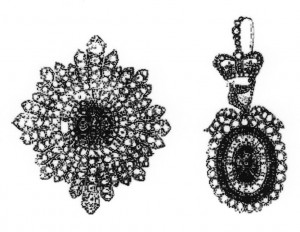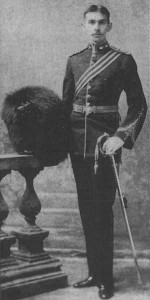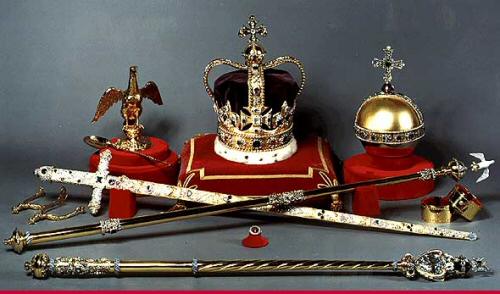Any visit to London requires not only a visit to the Tower of London but – providing you have sufficient funds of about £15 per person – a visit to the Jewel House there to see the English Crown Jewels. There you will find the Royal Regalia as used on Royal occasions by HM the Queen. There are also Royal jewels of past monarchs.
The security surrounding the entire Tower of London and in particular the Jewel House is extraordinarily high. It was not always so and in fact back in the 17th century the Jewels were literally stolen.
 The rogue who was responsible was none other than a fellow Irishman, Thomas Blood who was born in County Meath in 1618. His father was a prosperous blacksmith whilst his grandfather lived in Kilnaboy/Killinaboy Castle, County Clare and was a Member of Parliament.
The rogue who was responsible was none other than a fellow Irishman, Thomas Blood who was born in County Meath in 1618. His father was a prosperous blacksmith whilst his grandfather lived in Kilnaboy/Killinaboy Castle, County Clare and was a Member of Parliament.
When the English Civil War broke out in 1642, Blood came to England to fight for Charles First but when Oliver Cromwell (spit and curse at the mention of his name) got the upper hand and was destined to win, Blood without hesitation, changed coats and joined the Roundheads against the King. As a result, when Charles was defeated in 1653, Blood was made a Justice of the Peace and given a large estate.
Everything was going well until in 1660 after Charles Second was successful in recovering the throne, Blood fled with his wife and son back to Ireland. Whilst there he joined up with some disgruntled Cromwellians and tried to seize Dublin Castle and capture the then Governor, Lord Osmonde. He was unsuccessful and again fled, this time to Holland. Although he now had a price on his head and was one of ‘England’s Most Wanted’ he returned in 1670 and set up shop as a Doctor in Romford, in Essex. He assumed the name of Ayloffe.
It was there that he joined up with another bunch of ‘ne’r-do-wells’ and again tried to kidnap Lord Osmonde. They failed and Blood was lucky to escape. They then began to plan with the aim of stealing the Crown Jewels.
Then, as now, the jewels were kept at the Tower of London, (but then in a basement), and the ‘keeper’, Talbot Edwards, lived with his family on the floor above. A locked large metal grille protected the jewels which could be viewed by members of the public.
One day in 1671, Blood dressed as a Parson, went to see the jewels and befriended Edwards. He returned a few days later with his wife. As all the visitors were leaving, Mrs. Blood who was obviously part of the plan had a violent stomach upset and she and Parson Blood were taken to the apartment upstairs. A few days later Blood returned with a present of four pairs of white gloves for Mrs. Edwards as a token of his appreciation. Both families became good friends and met frequently over the coming months.
The Edwards had a pretty daughter and Blood proposed that his wealthy nephew and she should meet. As agreed, on 9 May 1671, at 7am, Blood, his nephew and two other men arrived as prearranged. Whilst the nephew and Edward’s daughter strolled and chatted in the grounds, Blood requested that he and his friends might view the jewels. Edwards agreed and they made their way to the basement. As soon as he unlocked the door, Blood struck Edwards with a mallet and stabbed him with his sword.
The grille was forced open and the Crown, Orb and Sceptre were removed. Blood flattened the Crown with the mallet and stuck it into a bag. He stuffed the Orb down his trousers. As the Sceptre was too long to go into the bag, one of the accomplices, Blood’s brother-in-law Hunt, tried to saw it in half.
At this point, Edwards came to and began to shout “Murder, Treason”. The thieves tried to make good their escape but Blood was arrested trying to leave the Tower after trying to shoot one of the guards.
When being questioned in custody, Blood became adamant that he would not answer his questioners, but repeated several times “I’ll answer to none but the King himself“. He was relying on his charm and ‘gift of the gab’ to influence the King whom he knew to have a likeness for rogues and scoundrels.
He was not wrong, for when he was taken to the Palace and questioned by King Charles, Prince Rupert, The Duke of York and other members of the Royal Family, Blood laid the ‘Blarney’ on in large doses. The King was so amused by Blood’s audacity especially when he claimed that the Crown Jewels were only worth £6,000 and not the £100,000 that was claimed. When the King asked Blood “What if I should give you your life“? he replied “I would endeavour to deserve it, Sire“.
As you may have guessed, Charles not only pardoned Blood, but to the utter disgust of many, including Lord Osmonde, he was given Irish lands worth £500 per year. Blood soon became a well-known figure around London and was a regular caller at the Court of the King.
Edwards recovered from his wounds and lived to a ripe old age at the Tower where he repeated his story of the events thousands of times to visitors.
Blood became ill in 1680 and died on August 24th of the same year at the age of 62.
The Crown Jewels, unlike the Irish ones, have never been stolen since that famous day in May, 1671 as it is reckoned that there is no-one about who could equal the audacity or daring of ‘Colonel’ Blood – the ‘Man who stole the Crown Jewels’.

Here is the story: On the 6th July 1907, the Irish Crown Jewels were found to be missing from Dublin Castle. The theft or burglary has never been resolved and although rumoured to have been ‘bought back’ by the Irish Government in 1927 for £5,000 this is thought to be confusion brought about by another intriguing matter regarding some Russian Crown Jewels.
The term Irish Crown Jewels is in fact a misnomer, in that they do not refer to the usual regalia of a Royal personage. They were in fact the insignia of the Order of Saint Patrick, which was instated by King George Third in 1783. Among the insignia of the order were a heavily jewelled Star and a badge. They were composed of rubies, emeralds and Brazilian diamonds.
In 1903, they were transferred to a safe, which was to be housed in a newly constructed strong-room in Dublin Castle. Would you believe it that the safe was too large for the doorway of the new room so instead the Officer of Arms of the Castle, Arthur Vicars, stored the safe in his office? The strong-room was to be redesigned but in fact this was never done. There were seven keys to the door of the office, which were held by Vicars and some of his staff. Two keys to the safe were held solely by Vicars.
The jewels were last seen when on 3rd July 1903, Vicars showed them to the librarian of the Duke of Northumberland. During the following three days, when the cleaner found the door of the offices open she reported the matter, but Vicars could not seem to care less. On the morning of the 6th July, she again saw the same door open together with the door to the strong-room also open. She again reported the matter but Vicars is quoted by the messenger as merely saying “Is that so?” or “Did she?”
At 2.15pm when Vicars asked his messenger, William Stivey to deposit an item in the safe, Stivey found it to be unlocked. He informed Vicars who immediately checked and found the jewels and other items, including some diamonds owned by his mother to be missing. The safe had not been forced or tampered with but opened with a key. Lock experts who were called to assist in the investigation confirmed this.
On 6th July 1907, four days before the arrival of King Edward Seventh and Queen Alexandra, when they were discovered to be missing, the King is alleged to have thrown a tantrum, exclaiming, “I want my jewels“.
 Now this is where some sinister intrigue enters the story. At the time it is said that Dublin Castle Administration Offices contained a rampant homosexual ring which included some famous people. One such was the brother of the heroic Antarctic explorer, Ernest Shackleton. One Irish Member of Parliament said at the time, that the office of the Administrator was nicknamed ‘Sodom and Begorrah’.
Now this is where some sinister intrigue enters the story. At the time it is said that Dublin Castle Administration Offices contained a rampant homosexual ring which included some famous people. One such was the brother of the heroic Antarctic explorer, Ernest Shackleton. One Irish Member of Parliament said at the time, that the office of the Administrator was nicknamed ‘Sodom and Begorrah’.
Again at the time, it was claimed that some of the homosexuals, in particular Shackleton, stole the jewels in order to pay off blackmailers.
There is confusion about the jewels having been bought back by the Irish Government in 1920 but in fact, Michael Collins with the aid of money raised for the new Irish Free State, made a loan to the ‘new’ Russian Republic and some of their state jewels were given as collateral. In actual fact, it appears that they were forgotten about until found in a state safe in 1940 when they were returned to Russia.
Vicars continually refused to resign over the issue and again refused to give evidence to the enquiry that was set up. However, he insisted up to the end, including the fact that he included the allegation in his will, that Shackleton, his second in command committed the theft.
Vicars met an untimely end when the IRA murdered him on 14th April 1921.
The crime remains unsolved and after one hundred years it is unlikely that it ever will


What a smart fellow you are, Mike! Thanks for that history lesson, I always look forward to your charming prose.
Fascinating stories; both of them; embellished with so much scandal and intrigue. You’ve also clearly illustrated what it is to be an Irish rogue, ha ha. What an engaging personality Blood must have been to be so audacious. As for Ireland, it sounds to me like Vicars sold their jewels upriver, the devil. Thank you for this highly cultural display of history. It was far more interesting than reading it in a text book.
[…] (http://subversify.com/2011/12/03/stolen-crown-jewels-english-and-irish-3/) […]
[…] http://subversify.com/2011/12/03/stolen-crown-jewels-english-and-irish-3/ […]
Romford was removed from Essex in 1965. Ever since Romford has been in London, in the London Borough of Havering in east London.